Parallel Turns
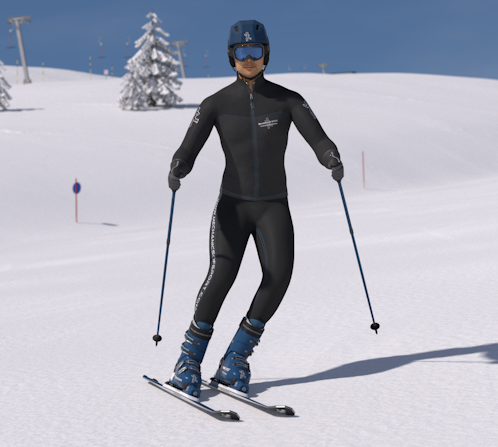
Parallel turns are turns where the skis always stay parallel to each other throughout each turn. This is generally considered to be the point where proper skiing begins, as up until now all the turns have used the snowplough, which is rarely used as soon as you don't need it.
On this page we are going to look at basic parallel turns. Parallel turns which use all the principles of parallel skiing, but to which extra techniques can be added to make the turns more advanced. These more advanced techniques are explained in further sections.
Please read the parallel skiing page before following the explanation here, if the principles explained on the parallel skiing page are not understood properly, the explanation here might be harder to follow and understand.
Parallel Turn vs Stem Turn
Parallel turns have many similarities with stem turns. To start a parallel turn you still need to lean forwards and bring your weight across onto both skis, and to finish a turn you still need to push on the outside/downhill ski. However parallel turns have an extra phase, the edge change, and because the snowplough is not used in the middle of the turn, as you turn through the fall line the skis do not brake at all and you can pick up a lot more speed. Therefore, to be ready for parallel turns, you have to be ready to go a bit faster.
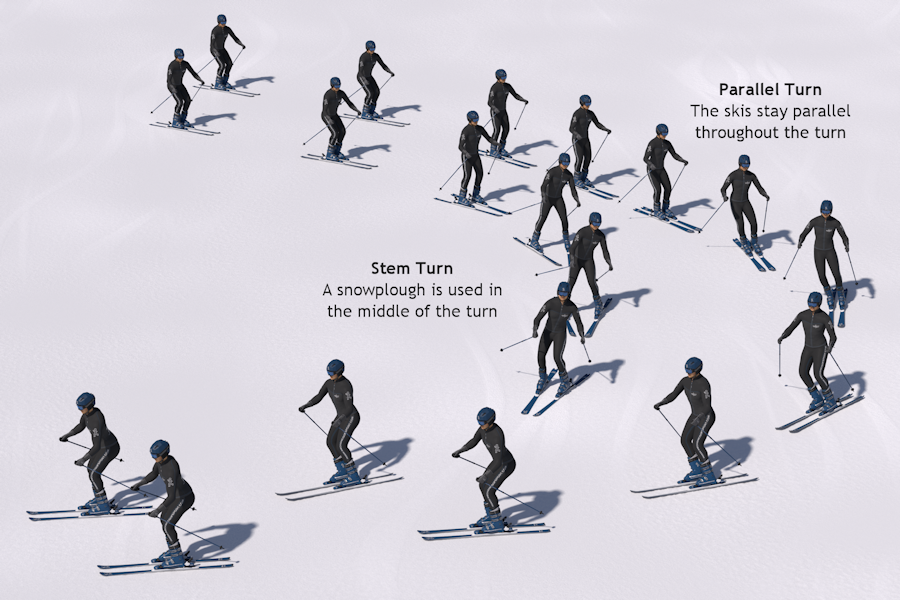
A parallel turn compared to a stem turn. In the parallel turn you pick up more speed around the turn as there is no snowplough to stop you accelerating so much.
Parallel turns also have a lot more variables to be considered, with the speed and direction of your velocity and the steepness of the slope having a large affect on turns.
Walk Through Explanation
Below is a walk through explanation of how to make a basic parallel turn, assuming that we start from skiing across the slope, standing in the correct traversing stance with our skis parallel, weight in the middle of the downhill ski, our shoulders turned slightly down the slope, and the skis sliding slightly sideways as they travel forwards.
Initiating the Turn
To initiate the turn, we extend upwards and lean forwards in a smooth motion, letting our hips come across over the downhill ski. As soon as we start this movement the ski tips should start to drop down the slope, and as they drop we begin to transfer our weight onto both skis. Ideally by the time you have reached the forward and extended position the skis should have dropped to the point that they are almost travelling straight along their length, and you should have transferred your weight so that it is almost evenly split between the skis. As you do this the direction of the skis should come to match the direction of your upper body. It is important this is done by letting the skis drop to match the body, rather than turning the body up the slope to match the skis. Once you are in this position you will need to stay there briefly until the skis are completely flat on the snow and travelling completely straight, at which point you are ready for the edge change.
If the initiation movement is performed well, and you are travelling with at least a good jogging pace, the skis should drop quickly to travelling straight along their length, so that you are soon ready for the edge change, making this part of the turn where your balance decreases very swift. But should you have not extended upward well enough to release the edges properly, or not leant far enough forward for the ski tips to drop properly, this phase of the turn can take a lot longer and you will need to stay in this extended forward position until the skis have turned enough to travel straight, with your speed continuing to increase the longer it takes. It is common for people to lack enough confidence to make this movement properly, but this only gives them more problems that they are unconfident about facing. They can start travelling faster than they are comfortable with before the turn has even properly begun, and they can start to run out of space to make the turn, as pistes are only so wide, or there might be other people in the way. The upward and forward movement required is not a large movement to look at, but it should feel as if you made a considerable movement, and it needs to be done properly to ski an efficient turn.
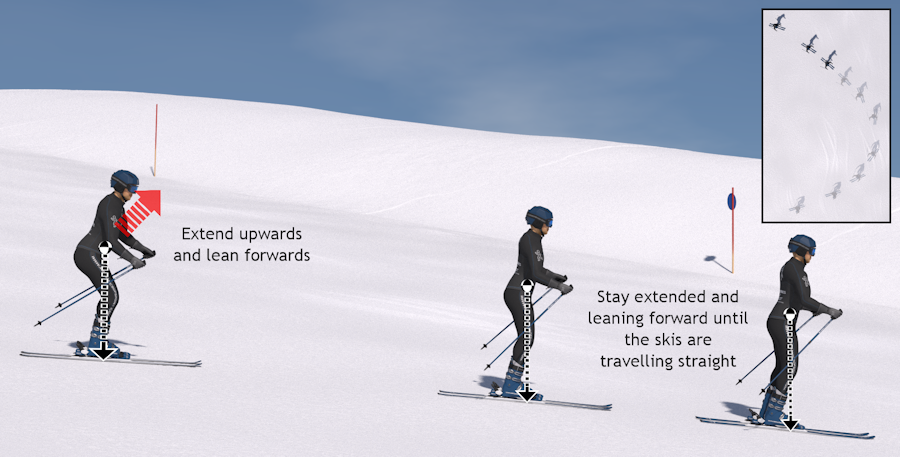
You need to extend upwards and lean forwards to initiate the turn, bringing your hips over the downhill ski, and starting to transfer your weight onto both skis as soon as the skis start to drop.
Changing Edges and Turning Across the Fall Line
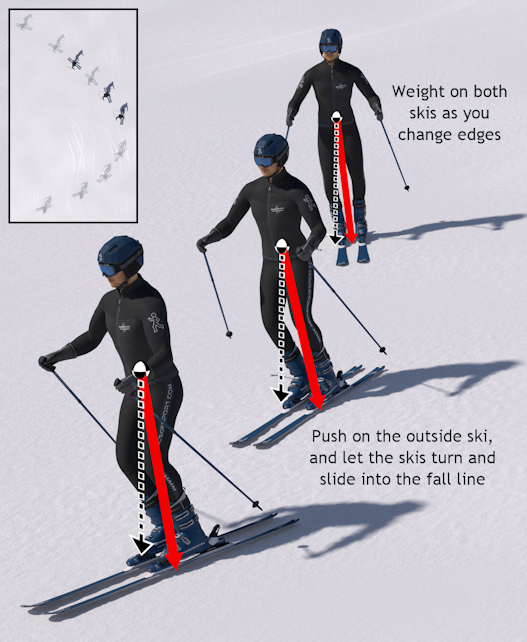
Start to push on the outside ski, while continuing to lean forwards.
Once the turn has been initiated and the skis are travelling straight, you are ready to change the edges. Unless the skis had no forward movement at the start of the turn, this point will always be before the skis point down the fall line, due to your initial momentum (as explained in using resistance). To change the edges, start to put all your weight onto the outside ski, while letting the body continue to gently fall towards the inside of the turn. This will bring the outside ski onto its edge, enabling you to push sideways on it and regain your balance. Keep pushing on the outside ski and leaning forwards until you have turned into the fall line, with your body in the same direction as the skis. As soon as you have made the edge change you can start to bend you knees a bit more and begin taking away that extended position. Once you have reached the fall line all that's left to do is turn back across the slope.

Start to push on the outside ski, while continuing to lean forwards.
Once the turn has been initiated and the skis are travelling straight and ready for the edge change, try not to spend too long in this position, as although you are pushing on both skis, your weight is actually over a point further down the slope, which will make you start to lose your balance, if you don't start to push on the outside ski soon enough. Some people get to this point and freeze a little as they are hesitant to start pushing on the outside ski, but it is important to do it and get on with the turn, as the longer you wait, the more speed you will pick up, and the more you will struggle to keep your balance.
Finishing the Turn
Once you have crossed the fall line, your weight continues to stay on the outside ski, but you start to bring your weight back along the ski lengthways and bend your knees more so that at the end of the turn you will be pushing on the middle of your foot, and your knee bend will be the same as at the start of the turn. Your shoulders also turn and point down the slope slightly more than your skis, to put our upper body in the correct position. As the skis turn across the slope it is important to let them slide sideways so that you can control the shape of the turn, and lose the extra speed you have picked up. You control the sideways slide by how much you lean over the outside ski, making small changes to edge angle and enabling the skis to slide a little more or less. It is important to lose the extra speed you have picked up as we want to finish the turn at the same speed we started it. Otherwise we will pick up speed with every turn, and at some point end up skiing faster than we are either ready for, or have space for. If you finish turning across the slope, but are still travelling too fast, you can lose the extra speed by letting the skis slide sideways more, or by turning up the slope slightly by bringing your weight a little behind the middle of your foot on your downhill ski. Once your speed is back under control, traverse in your desired direction by keeping your weight on the downhill ski and adjusting your forward lean slightly to point the skis at the angle you want, while controlling how much the skis slide. Now simply continue traversing across the slope until you want make your next turn in the other direction. As you get better at parallel turns, you will often start the next turn as soon as you have finished the turn before, with no traversing at a constant speed in between turns.
It is important to put all your weight on the outside ski in this part of the turn, as having your weight there makes the outside ski want to be further down the slope than the uphill ski (lateral weight distribution). Which is exactly what we need to happen. People can find this a bit difficult, as putting your weight on the point that is/will be furthest down the slope, requires you to lean down the slope, which is not as easy if you are affraid of the slope at all.
Although at the end of the turn you need to bring your weight back to the middle of your downhill foot lengthways (longitudinal weight distribution), turning across the slope changes the steepness angle of the ski, making your weight naturally come backwards without you needing to do anything. You have to watch out for this a bit, as this can make it easy to bring your weight a bit too far back along your foot, so that you start losing your balance, and control of the skis a bit. This is even easier to do if you are a bit afraid of the slope as you turn through the fall line.
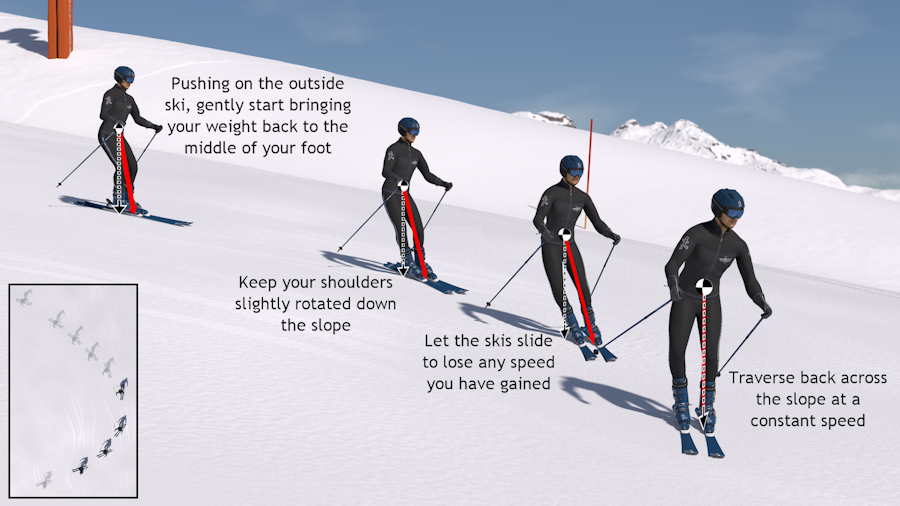
Finishing the turn. Notice how the skier is leant over towards the end of the turn so that he can slow down, but he is back upright once the speed has been lost and is traversing at a constant speed.
Overview
The main points to remember when making parallel turns are:
- The initiation is important. You must lean forwards and release the ski edges, otherwise the turn will take much longer to start and you will spend a lot more time with your balance reduced and your speed increasing.
- Once you have changed the edges you must put all your weight on the outside ski to bring the skis around.
- It is important to rotate your shoulders slightly down the slope, as this gives you more balance and uses stronger muscles.
- You must remember to let the skis slide sideways, especially towards the end of the turn. This helps you to turn more easily and gets rid of any excess speed you picked up through the turn. You should finish your turn at the same speed you started it, otherwise you will speed up with every turn you make and end up travelling too fast.
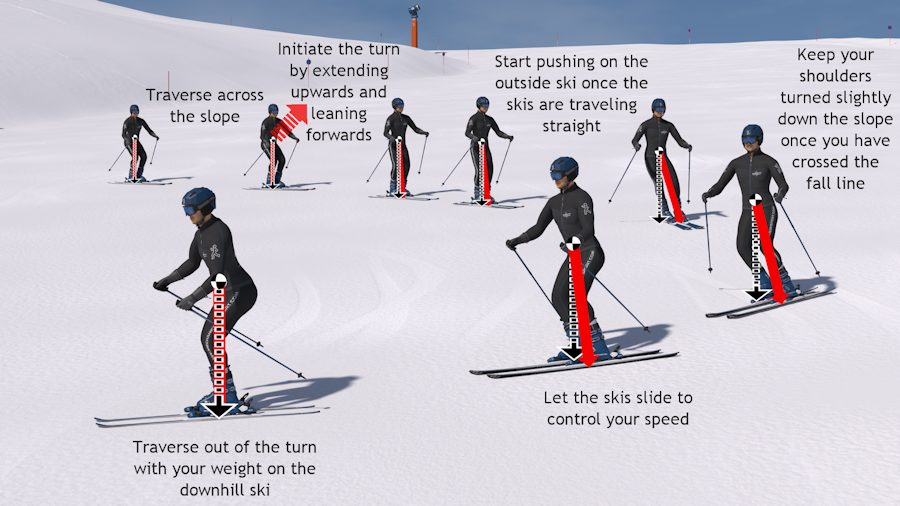
An overview of the steps in a parallel turn.
Ways Basic Turns Can Vary
The walk through above relates to a basic parallel turn. However, there are many variables that affect even gentle parallel turns. Here we will have a quick look at some that you are likely to come across.
Steepness of the Slope
The steepness of the slope is one of the easiest variables to consider. It largely determines how much effect your weight changes will have, and how much you will speed up in your turns. The steeper the slope, the quicker the skis will be able to turn around and the quicker your speed will build up in the turn.
Approach Speed
Your approach speed works in a similar way to the steepness of the slope, the faster you are going the more reaction force you can get from your skis. More reaction forces to keep your balance with, and stronger reactions when you lean forward to make the ski tips drop more rapidly.
So most of the time speed is your friend. The only times we generally start a turn with very little speed is on a steep slope where we know the reactions from weight changes will be stronger anyway, and you will pick up speed through the turn to keep your balance with. It is also important to have some initial speed so that the skis are sliding freely, and will not get stuck in the snow, or be too affected by small bumps.
Sliding Sideways on Approach
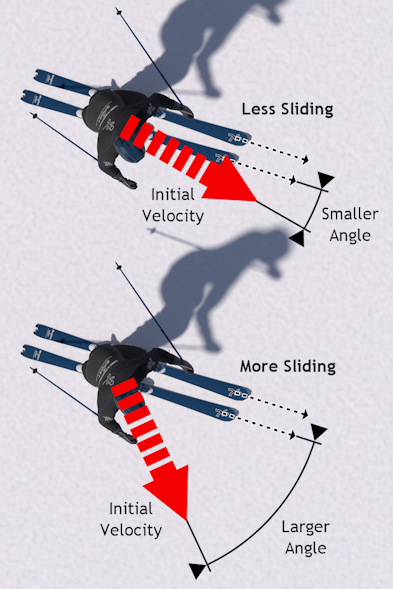
The angles shown are the minimum amount the skis will need to turn before the edge change. The more you slide sideways, the further the skis will need to turn before the edges can be changed, although this is not always a bad thing.
The amount you are sliding sideways as you start your turn determines how far the skis need to drop and turn before you are ready for the edge change. The more you are sliding sideways, the more your skis will be pointing across the slope relative to your actual direction of movement. This means that during the initiation phase you have to make the front of the skis drop further before they are travelling straight. Which in the wrong circumstances will make your turn initiation take longer.
If the skis are travelling almost straight along their length already, you will not need to turn much before the edge change, which usually makes the initiation phase nice and short.
However this doesn't mean that you should avoid sliding sideways as you start a turn, your ski orientation has to be matched to the steepness of the slope and your speed.

The angles show are the minimum amount the skis will need to turn before the edge change. The more you slide sideways, the further the skis will need to turn before the edges can be changed, although this is not always a bad thing.
Flatter Slopes
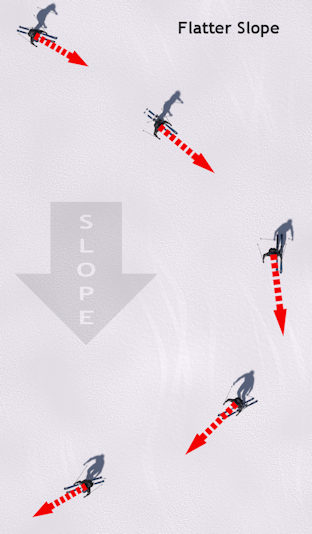
On a flatter slope you need to start turns with some initial speed, and only let the skis slide sideways a little bit.
On flatter slopes the ski tips will not drop very quickly down the slope, and you will not pick up much speed in the turn to help keep your balance with. Because of this, parallel turning is actually more difficult at slower speeds on a flatter slope, which are exactly the conditions that beginners tend to prefer.
On flatter slopes it is best to start off by travelling a bit faster across the slope, with the skis not sliding sideways so much. This gives you enough speed to help keep your balance and means that the skis don't need to turn so much before the edges can be changed, making the initiation phase quicker.

On a flatter slope you need to start turns with some initial speed, and only let the skis slide sideways a little bit.
The worst thing you can do as you initiate a parallel turn on a flatter slope is ski slowly with plenty of sliding sideways. Not only would you have to turn the skis so far that they point almost straight down the slope before the edges can be changed, but the combination of flat slope and slow skiing will make the skis very slow to turn. The result is a very slow turn, feeling very unbalanced, yet requiring more precise edge pressure changes to accomplish it.
Because speed is your friend, starting a turn by sliding sideways but faster can also work well on flatter slopes, but you will struggle to slide sideways fast enough on a flatter slope, unless you have taken speed onto the slope from somewhere steeper.
On a gentle slope you may well also find that you cannot turn too far across the slope before or after your turn, as that would decrease your speed to much. When making turns like this you have to keep leaning a little extra forwards at the end of the turn to stop the skis from turning too far across the slope.
Steeper Slopes
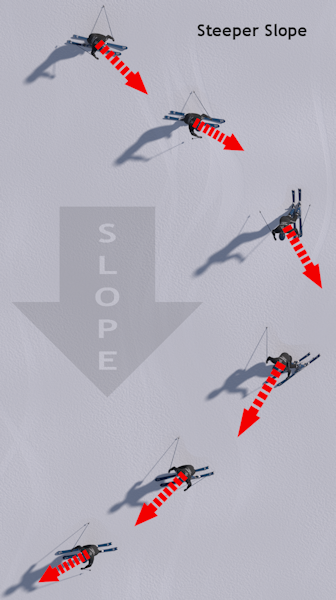
When starting to ski on steeper slopes, letting the skis slide sideways more can help you keep control of your speed, and reduces the amount your direction changes, which can make turns quicker and easier.
On steeper slopes you have the advantage that there is plenty of ski reaction force available, but you have to be more careful about your speed.
When we start to ski on steeper slopes it is good to start turns with a medium pace, and quite a lot of sideways sliding. Having a medium pace means the skis are sliding freely over the snow, making them easier to turn, and giving them enough power that they shouldn't be too affected by small bumps in the snow. Sliding sideways increases the proportion of your speed down the slope and so decreases your speed and momentum across the slope. However fast you are travelling across the slope, you are going to have to stop going in that direction, and start going across the slope in the other direction. The faster you are travelling across the slope, the longer it will take to slow down and start travelling across in the other direction, and the longer it takes, the more speed you will pick up while doing it.

When starting to ski on steeper slopes, letting the skis slide sideways more can help you keep control of your speed, and reduces the amount your direction changes, which can make turns quicker and easier.
So, sliding sideways can decrease the change of direction needed in a turn. It therefore make the turn quicker, picking up less speed. We don't need to worry about the skis having to turn more before the edges can be changed because, with the initial speed and the steep slope, the skis will drop and turn very quickly as long as the initiation is done properly.
Making turns like this also gives you lots of practice at sliding the skis sideways, which is a key skill to have for controlling speed and recovering from mistakes. As you get better at skiing steeper slopes, and incorporate more advanced techniques into your skiing, the goal will be to minimise the amount the skis slide sideways, as you will be able to control your turn shape and speed without the need for so much sliding.
Summary
Although it may not seem this way for a lot of people, gravity and speed are your friends in a parallel turn, provided you are not going to extremes that is. To make a parallel turn with balance you need a bit of speed, just like when riding a bike. And just like riding a bike, the more you practise, the better your balance will become at both faster and slower speeds.
Please note as soon as we get to this stage in skiing, the learning process slows down and we need a lot more practice to improve and move on to trying other skiing techniques. Also from here on all skiing techniques use parallel turns, although they are tailored to different conditions, or goals.
The information here is for basic parallel turns, there are many more advanced techniques that can be added to the basics described here. More information on these can be found in the next sections.
Common Mistakes:
- Leaning back - When you lean back it makes the back of the skis want to overtake the front of the skis, making them unstable. In parallel turns your weight needs to be brought forwards and backwards, but it always stays over the middle of the skis, or further forwards. Your centre of gravity should never come further back than the middle of your feet.
- Hesitating for too long while changing edges - The longer it takes for you to change edges and finish off the turn, the faster you will go in the meantime. You need to commit to the edge change before your speed frightens you from making the decision.
- Not leaning forwards enough to start the turn - The more you lean forward to initiate the turn the quicker the first stage of the turn will be. Although it can be scary to lean down the slope, if you do not lean forwards enough you can pick up more speed than you wanted, which can frighten you from actually making the turn.
- Having the skis too far apart - If the skis are too far apart you have to make a larger movement, which can make turning more difficult and take longer, and if the skis are really far apart the uphill ski will catch in the snow causing you problems.
- Not pushing on the outside ski enough at the end of the turn - The more you push on the outside ski at the end of the turn, the quicker you will come back to sideways. Therefore it is important to really push on the outside ski if you want to come around the turn quickly.
- Not letting the skis slide sideways - It may be scary to lean down the slope, but if we don't do it the skis won't be able to slide around properly, making them unable to turn as easily, and it hard to control your speed. The skis need to slide sideways for turns to be quicker and smaller, with more control over your speed.
- Not looking where you are going - Looking ahead at the snow you are aiming to ski over enables you to spot any bumps or obstacles with time to prepare for them, and encourages the body to move in the direction it needs to for making the turn.
More general common mistakes can be found in the Common Mistakes page of the Learning to Ski section.
Tips:
- Make a gradual change from the stem turn to the parallel turn on a gentle slope until you are more confident, then slowly progress onto steeper and steeper slopes. If you try and go too steep too soon, often fear brings the snowplough from the stem turn back, and you will be left not actually making parallel turns.
- Taking ski lessons will introduce you to skiing exercises based on how people learn to ski in real life, so that you learn to parallel turn with the correct technique.
- Sliding the skis around turns is key to skiing smooth parallel turns. If your turns are a bit wobbly, it is most likely because you are not letting the skis slide sideways enough through the turn (or you are going too slow to keep your balance properly). So it is key to practise letting the skis slide as much as possible, and get as much control as possible over sliding the skis.
On to the Hockey Stop section.